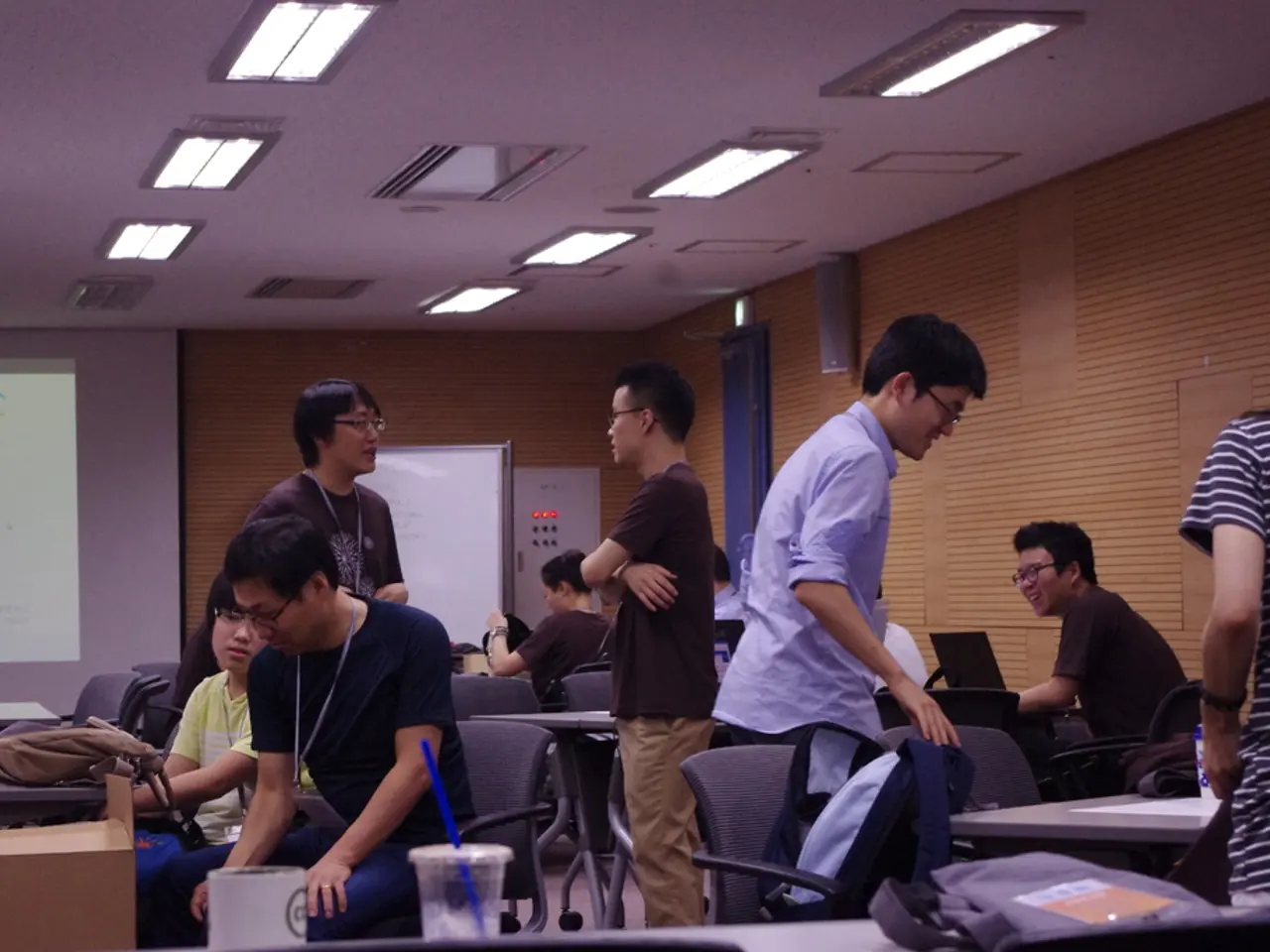Strategies for Integrating Technology in English Education
=====================================================================
In the modern era, technology has transformed the landscape of English language learning, offering a wealth of opportunities for learners to improve their fluency, confidence, and overall learning experience. This transformation is achieved by integrating a variety of pedagogically sound strategies with innovative technologies.
Interactive language applications and online courses, Virtual Reality (VR) and Augmented Reality (AR), social media platforms, audio-visual resources, gamification, mobile learning, Artificial Intelligence (AI), and social media platforms are all harnessed to create engaging, personalized, and socially interactive learning environments.
Interactive language applications and online courses offer flexible learning opportunities, allowing learners to practice English in diverse contexts. These platforms provide immediate feedback and adapt content to proficiency levels, ensuring an efficient and effective learning experience [1][2].
VR/AR technologies immerse learners in realistic language scenarios, enhancing contextual understanding and encouraging authentic communication. This builds confidence and fluency, as learners interact in simulated real-life situations [2].
Social media platforms and audio-visual resources facilitate authentic language use and cultural exchange. Learners can engage with native speakers, access diverse content, and practice real-life language skills outside the classroom [2][3].
Gamification incorporates game-like elements to increase motivation and engagement, encouraging repeated practice and deeper learning. Mobile learning extends access to language learning anytime and anywhere, supporting continuous exposure and practice through apps, podcasts, and microlearning formats [1][3].
AI enhances learning through automated grading, personalized feedback, and adaptive learning paths. AI-powered tools like automated essay grading and chatbots support teacher workload and provide students with timely, individualized input [4].
To maximize effectiveness, these technologies should be integrated within a pedagogically sound framework. This framework emphasizes personalization, social interaction, scaffolding and modeling, authentic materials, continuous assessment and feedback [1][2][3][4].
By strategically combining these technological tools within such a framework, educators can create dynamic, immersive, and supportive learning experiences that foster English fluency, learner confidence, and sustained motivation [1][2][3][4].
Regular use of interactive language apps leads to improvements in vocabulary retention and grammatical understanding. AI-powered language learning platforms can tailor lessons to suit individual progress and preferences, enhancing learning efficiency [1][4].
Audio-visual resources, such as podcasts, videos, and music, play a pivotal role in developing listening and comprehension skills by exposing learners to different accents and pronunciations [1].
Online language exchange platforms, such as Tandem and HelloTalk, facilitate real-time conversational practice with native speakers and other learners worldwide. Interactive language applications, such as Duolingo, offer an engaging and user-friendly approach to learning English through diverse exercises tailored to users' current proficiency levels [2].
YouTube and TikTok host a wealth of creative and instructional content for various aspects of language learning, from grammar tips to listening practices. Social media provides learners with an array of resources, language challenges, and peer feedback, creating a lively and supportive learning environment [3].
Gamification in language learning involves incorporating game-like elements into educational activities to boost engagement and motivation, like the Kahoot! platform. Online courses and Massive Open Online Courses (MOOCs) offer extensive resources for learning English, accessible from home, with platforms like Coursera and edX hosting a myriad of English courses [4].
AI is being applied in language learning to offer personalized and adaptive educational experiences, with AI-powered platforms like Elsa Speak providing real-time feedback on pronunciation and speaking skills. VR and AR provide immersive environments for practicing English without geographical constraints, simulating real-life interactions and improving speaking skills [5].
Mobile devices have made language learning more accessible and convenient with numerous language apps available for smartphones and tablets, like Babbel and Rosetta Stone. Strategies such as blending traditional teaching methods with digital tools, incorporating gamification, and using collaboration and communication platforms can create a dynamic and interactive learning environment [6].
Social media, like Facebook and Instagram, offers informal and engaging avenues for language practice and cultural exchange. The integration of technology into English language instruction requires thoughtful planning and a strategic approach to enhance learning outcomes [7].
Social media and collaborative platforms, like Facebook and LinkedIn, facilitate language exchange opportunities, fostering communication with native speakers and other learners worldwide. Educational brands and influencers on social media share content specifically designed to teach English through posts, stories, or live sessions [8].
By personalizing the approach, AI accelerates the learning process, making it both effective and enjoyable. AI adapts dynamically to adjust the difficulty level and content as learners progress, ensuring they remain challenged and engaged at a suitable pace [9].
The power of technology in English language learning is undeniable, offering learners a wealth of opportunities to improve their skills in a dynamic, engaging, and personalized manner. As technology continues to evolve, so too will the possibilities for English language learning, promising an exciting future for learners and educators alike.
References:
[1] European Commission. (2021). The Future of Education and Training: A European Approach for a Strong Social Market Economy. Retrieved from https://ec.europa.eu/info/publications/future-education-and-training-european-approach-strong-social-market-economy_en
[2] Project-based Language Learning. (2021). The Role of Technology in Language Learning. Retrieved from https://project-based-language-learning.com/role-technology-language-learning/
[3] UNESCO. (2020). The Future of Education: Technology and Inclusion. Retrieved from https://en.unesco.org/themes/future-education/technology-and-inclusion
[4] Pearson. (2019). The Role of Artificial Intelligence in Language Learning. Retrieved from https://www.pearson.com/articles/artificial-intelligence-language-learning.html
[5] Allen, C. (2020). The Future of Language Learning: Virtual Reality and Augmented Reality. Retrieved from https://www.britishcouncil.org/voices-magazine/future-language-learning-virtual-reality-and-augmented-reality
[6] Khan, S. (2019). The Impact of Mobile Learning on English Language Learning. Retrieved from https://www.researchgate.net/publication/333683177_The_Impact_of_Mobile_Learning_on_English_Language_Learning
[7] Zhang, J. (2020). The Role of Social Media in English Language Learning. Retrieved from https://www.researchgate.net/publication/342764948_The_Role_of_Social_Media_in_English_Language_Learning
[8] Lang, K. (2019). The Role of Gamification in English Language Learning. Retrieved from https://www.researchgate.net/publication/335472187_The_Role_of_Gamification_in_English_Language_Learning
[9] Elsa. (2021). The Future of Language Learning with AI. Retrieved from https://elsa.co/blog/the-future-of-language-learning-with-ai/
Advanced grammar can be practiced and honed using AI-powered language learning platforms like Elsa Speak, which provide real-time feedback and adaptive lessons. Language exchange platforms, such as Tandem and HelloTalk, allow learners to engage in conversation with native speakers worldwide, providing opportunities for authentic language use in various cultural contexts, thereby contributing to learner's lifestyle enrichment and education-and-self-development.




